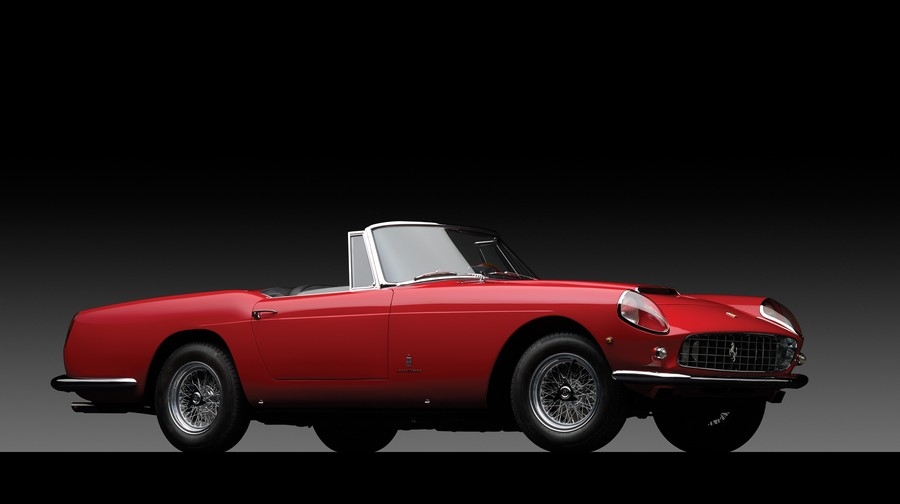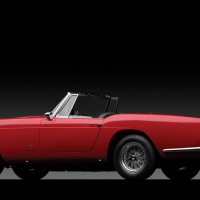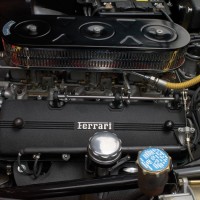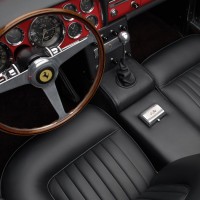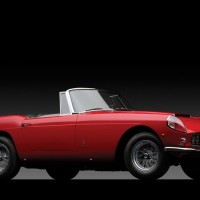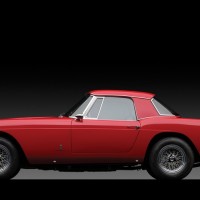SCM Analysis
Detailing
| Vehicle: | 1961 Ferrari 250 GT Cabriolet Series II by Pininfarina |
| Number Produced: | 200 |
| Original List Price: | $13,000 |
| Tune Up Cost: | $3,000 |
| Distributor Caps: | $400 (two required) |
| Chassis Number Location: | Left frame member by steering box |
| Engine Number Location: | Right rear above motor mount |
| Club Info: | Ferrari Club of America |
| Website: | http://www.ferrariclubofamerica.org |
| Investment Grade: | B |
This car, Lot 110, sold for $2,035,000, including buyer’s premium, at RM’s “Art of the Automobile” auction at Sotheby’s, New York, NY, on November 21, 2013.
The 250 MM of 1952 ushered in the Ferrari 250 series. This series of amazing sports cars is arguably the most important sequence of automobiles ever produced.
Most of Ferrari’s early cars were dual-purpose competition and GT models, but with the 250 series, Ferrari began to formulate a series of single-purpose GT cars. These models were intended to offer high-speed touring with a degree of comfort never offered before. Augmenting Ferrari’s vision were construction projects at both Ferrari and Pininfarina that would greatly increase the speed and efficiency of building cars.
The 250 Pininfarina Series II was one of the first beneficiaries of the new technology. The original 250 Pininfarina was an elegant design with complex form and jewel-like detail that could only be accomplished by laborious manual construction. The Series II was mechanically superior, but in a concession to faster construction, the car was rather sober in design and lacked the detailing of its predecessor. One of the missing details was the covered headlights of the Series I. Most of the Series II cars had open lights, which probably cut a day out of the production schedule — but at the cost of replacing the defining lights of the original Cab with protrusions that displayed necessity over design.
A pioneering sale
“The Art of the Automobile” was an RM auction at the prestigious Sotheby’s auction house. Held at Sotheby’s New York City showroom in the epicenter of Manhattan’s art district, the sale was a test to see if a tie-in with the famous art house could elevate automobiles from transportation to art. If a couple square meters of painted canvas could bring tens of millions of dollars, what could a moving sculpture do?
RM’s usual top-shelf promotion was augmented with Sotheby’s pitch to the art crowd. The event made New York social calendars and received coverage in many local publications. RM’s selections were specifically chosen to complement the art theme. There were only 33 automobile lots, but they were all one-offs or small-production examples with dramatic design that blended performance with high style.
Lot 110, this Ferrari 250 GT Cabriolet Series II, Chassis 2473, was a bit of an unfortunate choice for this event. I’ve long felt that Ferraris were art — incredible sculptures that not only are beautiful to look at but perform to a standard that can also be considered art. A Series II Cabriolet fulfills the mechanical criteria, but it is one of the least-artistic Ferraris.
A secret of the high-end automobile trade is that just because something is rare doesn’t mean it’s valuable. Many times, few were produced because few people wanted one. Just because something is old doesn’t necessarily change that fact. Chassis 2473 is one of very few covered-headlamp Series II Cabriolets, but does that make it more valuable?
Everyone wins here
The market spoke with a price that was nearly double what a standard open-headlamp example would bring. It’s hard to discern if this had to do with the desirability of this particular car, the uniqueness of the venue, or the continued upward spiral of the classic-Ferrari market. The current high-end Ferrari market is uncharted territory. Anyone who professes to know what’s going on is making it up. These days, the only thing that’s nearly certain is the next one will bring more money than the last one.
Assuming the condition of chassis 2473 matched its billing, it was a top example of a Series II Cabriolet. It also was a unique variation, but historically it is a Ferrari oddity rather than an important Ferrari. Fifteen percent to 20% would have seemed the appropriate premium for the covered headlights, but “appropriate” and reality don’t always intersect in the Ferrari world. It’s hard to say the seller got the best of this transaction when the chances of the buyer getting a good return on investment are high, but until the next turnover, the seller prevailed.
The real winner here was RM/Sotheby’s. All it takes is a look at a Lamborghini Miura to see that an automobile can be art. It’s been a long time coming, but a crossover was due — and RM has started the charge. People pay tens of millions of dollars for glass-encased zebras suspended in formaldehyde or sculptures patterned after balloon animals. A Ferrari 250 Testa Rossa is every bit as artistic and a hell of a lot more fun to own. Hurray for RM, and may the march continue. ♦
(Introductory description courtesy of RM Auctions.)
